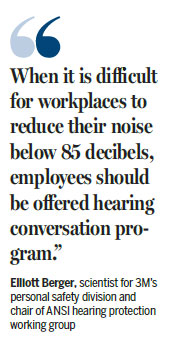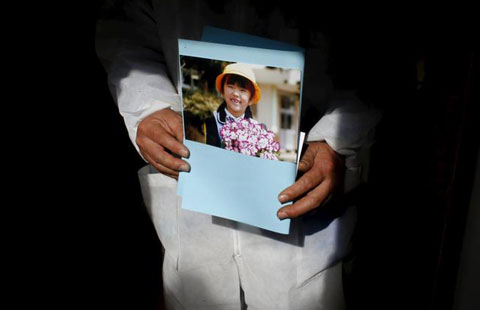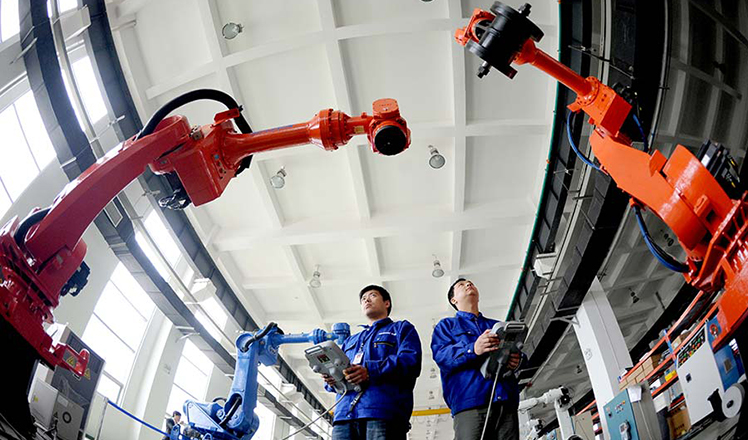Hearing loss is a growing problem
Updated: 2016-03-14 14:12
By Wang Zhuoqiong(China Daily)
|
|||||||||
Excess workplace noise causes 40 percent of the hearing problems reported in China, according to the country's Occupational Safety and Health Association.
Speaking at the Workplace Noise Harm and Hearing Protection Summit in Beijing, the association's Director-General Wang Dexue said deafness caused by occupational noise needs to be addressed urgently by the government, employers and society.
The event was co-organized by the association and 3M Co.
Wang released that figure as part of the International Ear Care Day on March 3, an annual event held around the world to promote ear and hearing care.
The day was first launched in 2007 at the First International Conference on Prevention and Rehabilitation of Hearing Impairment in Beijing.
His research also found that 16 percent of patients suffering from irreversible hearing loss in China blamed their workplace, or environmental noise, for their condition.
Elliott Berger, scientist for 3M's personal safety division and chair of ANSI hearing protection working group, told delegates at the summit that compared with toxic materials, effects and sources of sound are often more difficult to measure and detect.
But when decibel levels reach 85 - the sound of city traffic from inside a car, for instance, any exposure lasting more than eight hours is harmful to humans, said Berger.
A possible result, he said, is the condition tinnitus - the hearing of sound when no external sound is present, often described as "ringing in your ear" - which can be considered a symptom of longtime exposure to a noisy environment.
Berger quoted statistics from the National Institute for Occupational Safety and Health in the United States, an agency responsible for conducting research into the prevention of work-related injury and illness, that show around 22 million Americans are exposed to excess noise, but that's over a quarter of the reported cases in China.
He said removing sources of noise should be a priority for companies, if circumstances allow, and more firms should be adopting protection and preventive measures. He also advocated support to improve employees' self-protection awareness, and better monitoring.
"When it is difficult for workplaces to reduce their noise below 85 decibels, employees should be offered hearing conversation program," said Berger.
3M has been working in China on research into occupational hearing-loss prevention and protection since 1991, and Berger claimed many mechanical, textiles, chemicals, and automobile manufacturers have already adopted the company's prevention and protection examination systems to measures the adequacy of their own hearing-protection equipment.
The World Health Organization estimates 5.3 percent of the world's population, or around 360 million people, have disabling hearing loss.
The most recent figures for China were from 2006, putting its national corresponding figure at 27.8 million, with 150 million people suffering some kind of hearing handicap.
But just 5 percent of Chinese patients chose to seek help for their hearing difficulties, compared with 20-25 percent in Europe and North America, according to the statistics from National Health and Family Planning Commission.
wangzhuoqiong@chinadaily.com.cn

(China Daily USA 03/14/2016 page15)

 Snapshots at Two Sessions
Snapshots at Two Sessions
 Beijing sees blue sky during the two sessions
Beijing sees blue sky during the two sessions
 Fukushima five years on: Searching for loved ones
Fukushima five years on: Searching for loved ones
 Robots ready to offer a helping hand
Robots ready to offer a helping hand
 China to bulid another polar ship after Xuelong
China to bulid another polar ship after Xuelong
 Top 10 economies where women hold senior roles
Top 10 economies where women hold senior roles
 Cavers make rare finds in Guangxi expedition
Cavers make rare finds in Guangxi expedition
 'Design Shanghai 2016' features world's top designs
'Design Shanghai 2016' features world's top designs
Most Viewed
Editor's Picks

|

|

|

|

|

|
Today's Top News
What ends Jeb Bush's White House hopes
Investigation for Nicolas's campaign
Will US-ASEAN meeting be good for region?
Accentuate the positive in Sino-US relations
Dangerous games on peninsula will have no winner
National Art Museum showing 400 puppets in new exhibition
Finest Chinese porcelains expected to fetch over $28 million
Monkey portraits by Chinese ink painting masters
US Weekly

|

|








